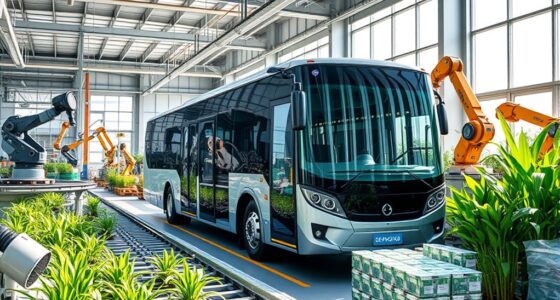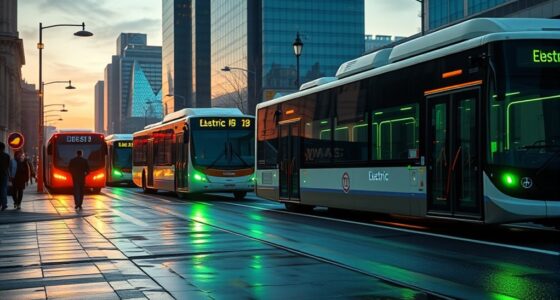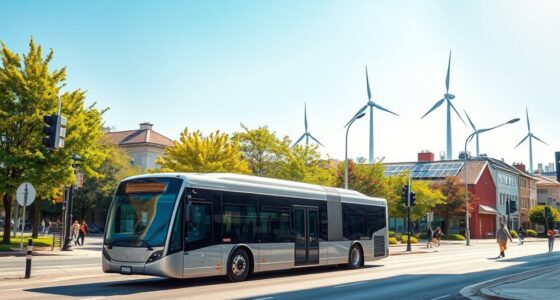London’s switch to electric buses has substantially improved air quality by lowering NOx and CO2 emissions through policies like ULEZ, fleet upgrades, and advanced charging infrastructure. With over 1,000 electric buses now in service and innovative systems like high-capacity chargers and smart power grids, the city has seen measurable health and environmental benefits. Exploring how these strategies work together will show you the full impact of London’s transformative approach.
Key Takeaways
- London has reduced roadside NO2 levels by nearly 50% since 2016 through policies like ULEZ and fleet upgrades.
- Over 1,000 zero-emission buses now operate in London, significantly decreasing local air pollution.
- Deployment of fast-charging infrastructure and smart grid solutions supports reliable electric bus operation and emission reduction.
- Electric buses eliminate tailpipe emissions, leading to measurable improvements in urban air quality and public health.
- The London case demonstrates how fleet electrification and infrastructure investments effectively improve air quality citywide.
Progress in Reducing London’s Air Pollution

London has made significant progress in reducing its air pollution over recent years. You’ll notice that annual average roadside NO2 levels have dropped by nearly half since 2016, showing clear improvement.
London’s roadside NO2 levels have nearly halved since 2016, highlighting significant air quality improvements.
The Ultra Low Emission Zone (ULEZ) has played a key role, cutting NO2 concentrations by 27% across the city, especially in central and inner London. Outer London also saw a 14% decrease in NOx levels from cars and vans after ULEZ expansion.
Despite these gains, air pollution remains a concern, particularly in outer boroughs where most pollution-related deaths occur. You can see that policies like ULEZ, combined with stricter emission standards and technological advancements, are making a difference.
Additionally, the adoption of electric buses, which have low input lag and produce zero tailpipe emissions, contributes significantly to improving air quality. The shift towards AI-driven analytics in monitoring pollution levels helps policymakers make more informed decisions. Implementing advanced emission control technologies further enhances these efforts and reduces harmful pollutants. Still, ongoing efforts are essential to tackle remaining challenges and guarantee cleaner air for all residents.
Fleet Electrification Milestones and Goals
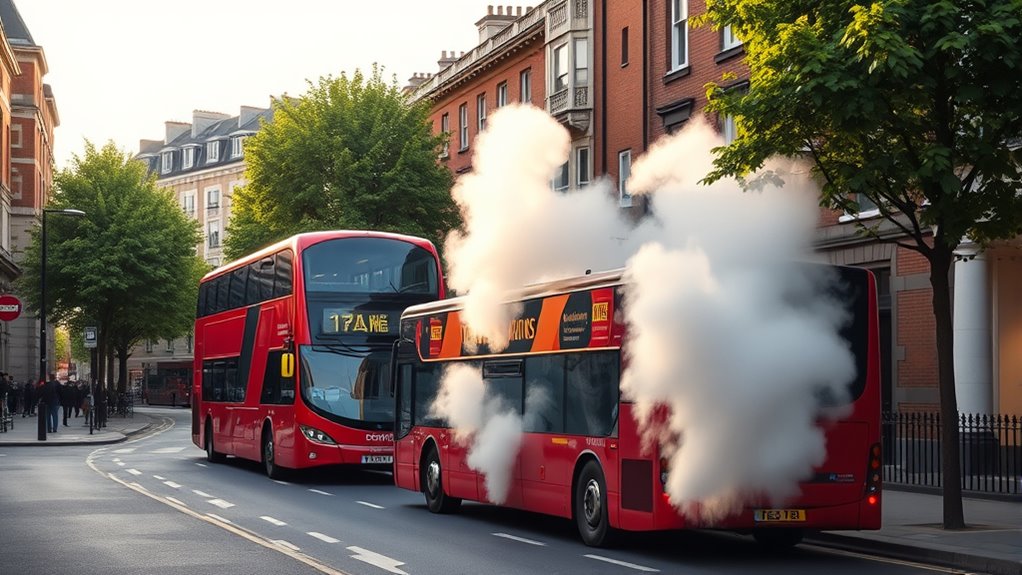
With over 1,000 zero-emission buses now operating, London has achieved a major milestone in its fleet electrification journey. Currently, about one in seven buses in the city are electric, making London’s fleet the largest in Western Europe. The shift includes deploying models like the Alexander Dennis Enviro400EV and fully electrifying routes such as Route 63. Strategic partnerships, infrastructure development, and government backing are key drivers, ensuring London continues leading in sustainable transportation and making significant progress toward its net-zero carbon ambitions. Additionally, regulatory frameworks are supporting this transition by fostering innovation and ensuring compliance across the sector. Incorporating offensive security measures into planning processes further enhances the resilience of transportation infrastructure against cyber threats, emphasizing the importance of attention in implementing secure and effective systems. As the adoption of electric buses accelerates, integrating sustainable practices throughout the supply chain becomes increasingly critical to sustain this momentum.
Infrastructure Development and Strategic Partnerships
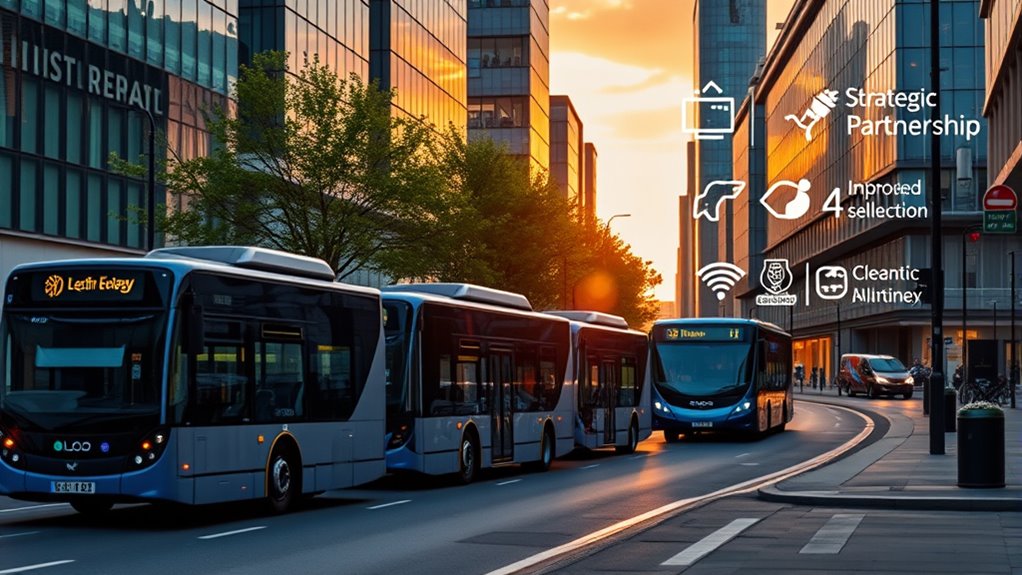
Building a robust infrastructure is crucial to supporting London’s expanding electric bus fleet. You’ve seen how thorough power systems, including charging stations and grid connections, guarantee reliable operation. Incorporating renewable energy sources into the grid can further enhance sustainability and reduce carbon emissions associated with charging infrastructure.
Depot upgrades, like those at Walworth, accommodate maintenance and charging needs seamlessly. Smart technology enhances efficiency, allowing real-time data monitoring and optimized energy use. Incorporating automotive scan tools can further improve maintenance procedures by diagnosing issues quickly and accurately.
Strategic partnerships, notably with Siemens, provided essential financial backing and technical expertise, minimizing costs and accelerating deployment. Collaborations with manufacturers such as Alexander Dennis helped develop suitable electric models.
These alliances also improve supply chain conditions, ensuring sustainability and resilience. Incorporating electric vehicle components into planning further supports the transition to cleaner transportation. Additionally, integrating specialized conversion kits can enhance existing fleet capabilities and extend vehicle lifespans. Government support further fuels progress, with potential funding boosting the timeline.
Together, these infrastructure developments and strategic partnerships lay a strong foundation for London’s journey toward cleaner, greener transportation.
Impact of Electric Buses on Public Health
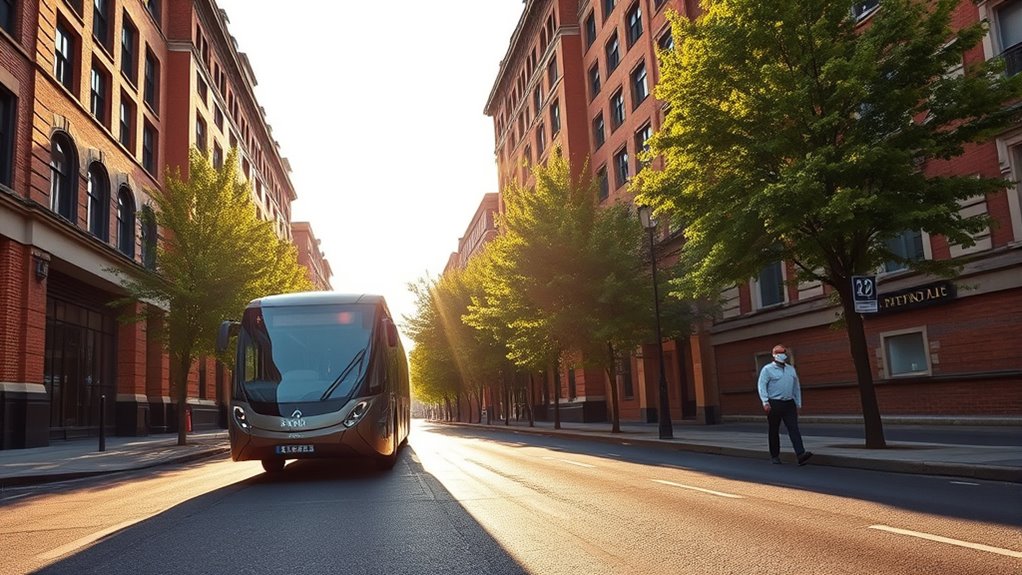
Electric buses substantially improve urban air quality by eliminating tailpipe emissions of harmful pollutants like nitrogen dioxide (NOx). This shift reduces your exposure to respiratory irritants, especially in busy city areas. A portable camping toilet can further enhance comfort for those spending extended time outdoors, reducing the need to find public facilities. As a result, you’ll notice cleaner air, which helps prevent respiratory issues like asthma and bronchitis, particularly in vulnerable groups such as children. Reduced NOx and particulate matter lower the risk of chronic respiratory and cardiovascular diseases over time. Furthermore, electric buses contribute to public health by lowering overall pollution levels, fostering healthier communities. The transition to electric buses also promotes the use of renewable energy sources, which further amplifies environmental and health benefits. Electric buses also help address health disparities by decreasing pollution in deprived neighborhoods where air quality tends to be worse. The reduction of air pollutants from these initiatives significantly benefits vulnerable populations. Overall, this transition supports public health by creating safer, healthier urban environments.
Electric buses improve air quality by eliminating harmful tailpipe emissions in city areas.
You’ll benefit from fewer pollution-related health problems, potentially lower medical costs, and a better quality of life thanks to cleaner air.
Environmental Benefits and Emission Reductions
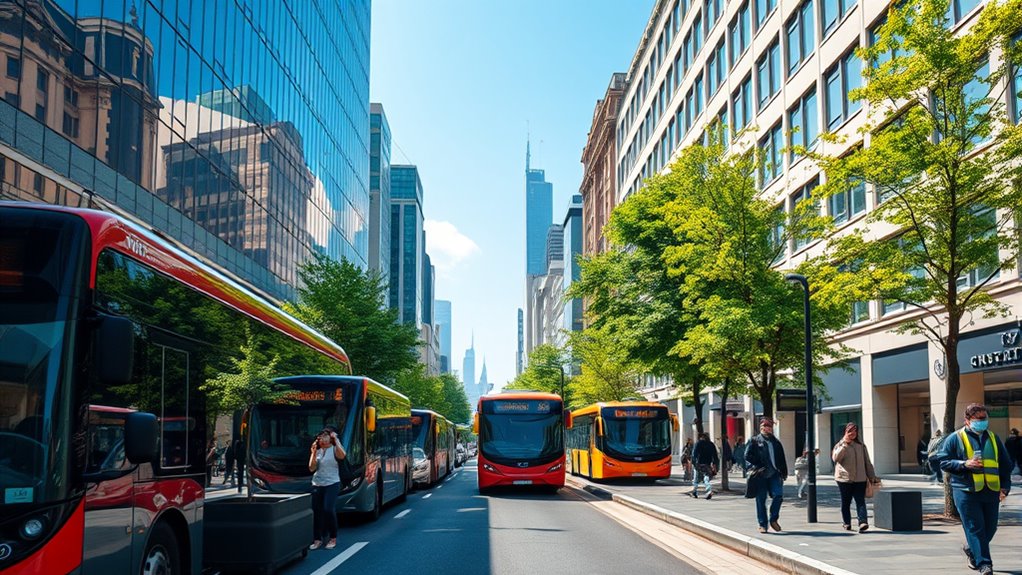
Adopting electric buses delivers significant environmental benefits by eliminating harmful tailpipe emissions like nitrogen oxides (NOx) and particulate matter. This shift helps improve air quality across London, especially in densely populated areas.
Over the past decade, Go-Ahead London’s electric buses have saved around 40,000 tons of carbon emissions, highlighting their role in reducing greenhouse gases.
The city’s strategy includes establishing low emission zones, which have decreased NOx emissions by 84%, and phasing out diesel buses since 2018. All new buses now meet strict standards, further cutting pollution.
Investments in infrastructure and real-time air quality monitoring enhance these efforts.
Economic Growth and Job Creation in Green Transport
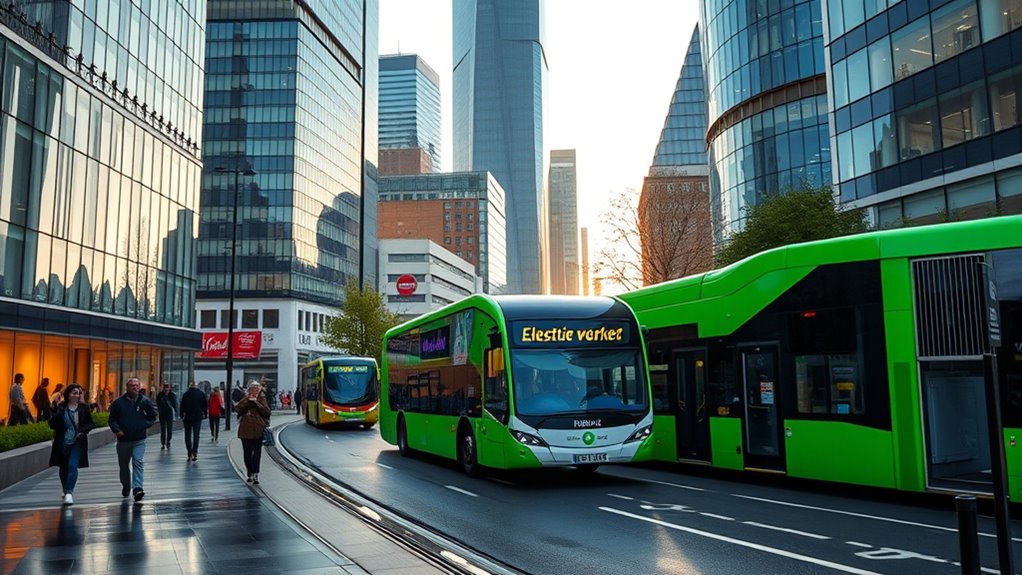
As London advances its efforts to improve air quality through cleaner transportation methods, the economic benefits of green transport become increasingly evident. Bus users generate around £39.1 billion annually for local economies, supporting retail, leisure, and hospitality sectors.
About 2.2 million workers rely on buses, contributing £72 billion in earnings and generating £15 billion in tax revenue each year. Shifting to electric buses involves significant investments, like Go-Ahead’s £500 million upgrade, creating jobs in engineering, maintenance, and energy sectors. Incorporating sustainable infrastructure techniques into fleet upgrades can further enhance the environmental and economic outcomes of these initiatives.
These efforts boost supply chains for batteries and charging infrastructure, fostering regional economic growth. The development of renewable energy sources can further reduce operational costs and environmental impact. Additionally, integrating efficient energy management strategies can optimize energy use and improve overall system efficiency. Public-private collaborations and government incentives accelerate fleet electrification, leading to operational savings and long-term fiscal gains.
Innovations in Charging and Power Supply Systems
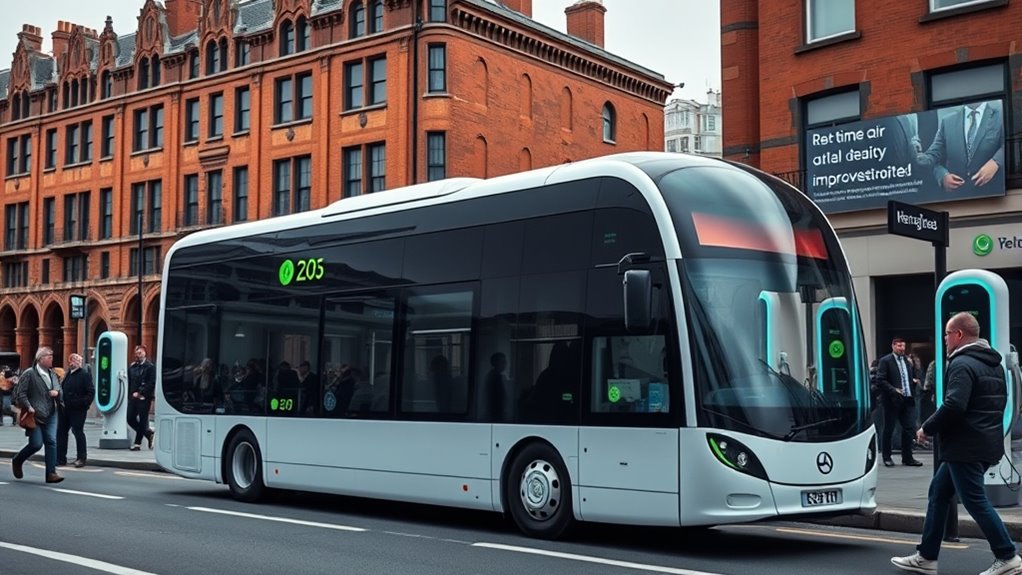
Innovations in charging and power supply systems are transforming the way London’s electric buses operate, making the shift to zero emissions more practical and efficient. High-speed pantograph chargers now enable buses to top up in as little as six minutes, while wireless charging introduced in 2022 offers rapid, contactless energy transfer. The development of charging infrastructure with stations featuring 500 kW capacity and inverted pantographs at route endpoints allows buses to fully recharge without garage visits. Infrastructure improvements include stations with 500 kW capacity and inverted pantographs at route endpoints, allowing buses to fully recharge without garage visits. OppCharge systems standardize opportunity charging, ensuring compatibility across models, and smart controls optimize energy use. The integration of smart grid technologies further enhances energy management and efficiency. Additionally, implementing energy storage solutions can buffer energy demands, reducing strain on power supplies during peak times. Dual power supplies and UPS protect the system’s reliability, reducing downtime. These advancements enable buses to complete routes without returning to depots, cut fleet requirements, and markedly improve urban air quality by minimizing emissions. Juice Cleansing techniques demonstrate how optimizing energy intake can enhance overall system performance and health.
Policy Measures Driving Zero-Emission Adoption

Policy measures in London play a crucial role in driving the widespread adoption of zero-emission buses. The city’s ULEZ standards ensure all buses meet strict emission criteria, pushing operators toward cleaner vehicles.
London’s target to have a fully zero-emission bus fleet by 2034—potentially earlier—sets a clear goal. Since 2019, all double-deck buses are at least hybrid, and by 2020, all single-deck buses are zero emission.
London aims for a fully zero-emission bus fleet by 2034, with hybrids since 2019 and all single-deck buses zero emission by 2020.
The introduction of Low Emission Bus Zones has markedly reduced NOx levels, with an 84% reduction in targeted areas.
Legislation mandates new buses entering the fleet to be zero emission, and existing vehicles are retrofitted to meet standards. These policies, backed by over £300 million in investments, foster the shift to cleaner, healthier transportation.
Monitoring and Data Collection for Air Quality Improvement
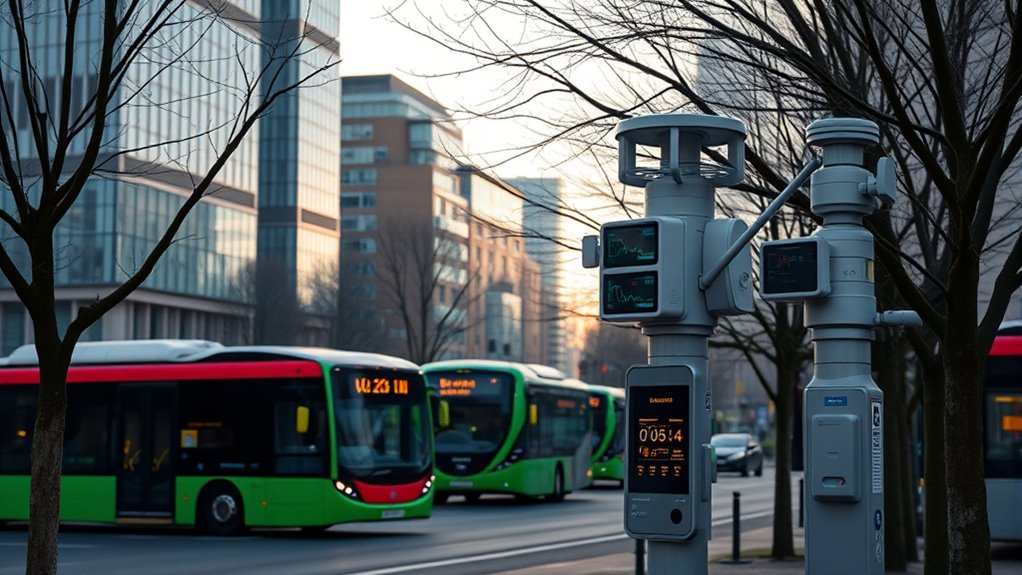
Effective monitoring and data collection are essential for tracking the impact of electric buses on air quality in London. You’ll rely on frameworks like the Low Emission Bus Zones (LEBZs), where air quality improvements are closely observed. Regulatory networks evaluate emission reductions, while vehicle emission studies measure NOx and CO2 under different traffic conditions.
Data analytics, including dashboard video recordings, help identify pollution hotspots and vehicle types responsible. Technologies like fast-response instruments and mobile monitoring labs provide real-time emission data. Grid connection and charging infrastructure support consistent electric bus operation, ensuring continuous monitoring.
These efforts lead to measurable decreases in NOx and CO2 emissions, improving public health. Challenges include traffic congestion, infrastructure costs, and technological limitations, but ongoing innovations aim to enhance data collection accuracy and scope.
Global Implications and Replication of London’s Success
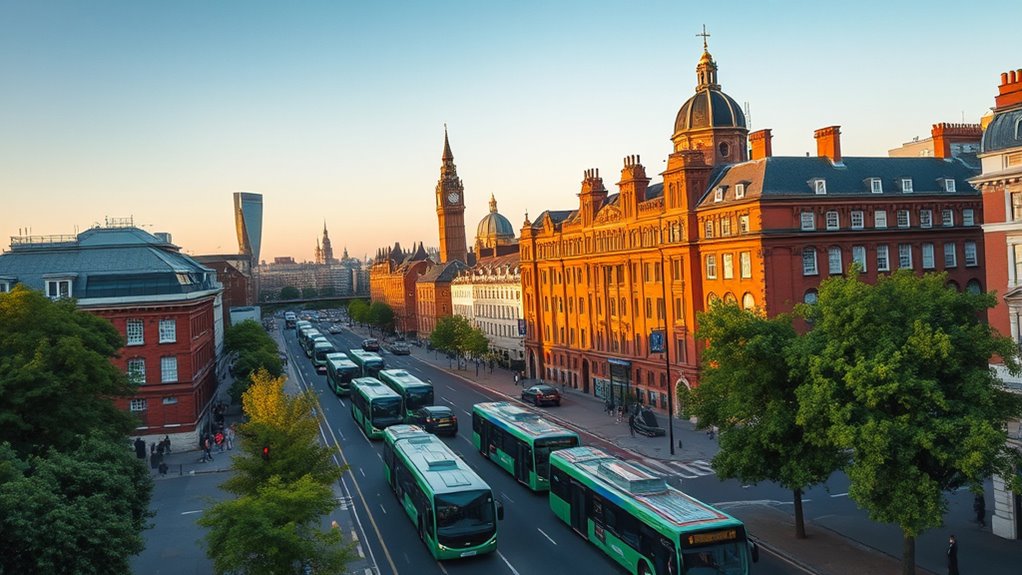
London’s success in reducing urban air pollution through electric buses offers a valuable blueprint for cities worldwide.
Globally, China dominates the electric bus market, with 99% of units and over 163,000 buses deployed by 2019, driving down costs and expanding manufacturing.
European and North American markets are now poised for growth, thanks to diesel bus sunset clauses and zero-emission targets.
Shenzhen’s fleet of over 16,000 electric buses exceeds those of North American transit agencies combined, demonstrating scalability.
Policy tools like subsidies, incentives, and local manufacturing support are key to replicating success elsewhere.
Additionally, market projections of 78.4% CAGR highlight rapid growth potential.
If you adapt policies, invest in infrastructure, and follow China’s manufacturing model, you can accelerate air quality improvements in your city.
Frequently Asked Questions
How Do Electric Buses Impact Noise Pollution Levels in London?
You might notice that electric buses considerably lower noise pollution in London by eliminating the loud diesel engine sounds. They create quieter streets, making urban areas more peaceful for pedestrians and residents.
To guarantee safety, artificial sounds alert pedestrians when buses move slowly, balancing quietness with safety.
As more electric buses are adopted, the overall noise levels decrease, leading to a calmer, more pleasant city environment.
What Challenges Are Faced in Expanding Charging Infrastructure Across All Routes?
Imagine trying to fill every street with charging stations, but your power grid’s like a fragile teapot ready to spill. You face challenges in scaling infrastructure to meet demand, especially in rural areas.
It’s a balancing act—you need enough stations, reliable tech, and support systems without overloading the grid. Securing funding and standardizing charging tech also prove tricky, but these steps are crucial for a seamless, citywide electric bus network.
How Does the Transition to Electric Buses Affect Bus Driver and Staff Training?
You’ll find that shifting to electric buses substantially impacts staff training. You need to learn new vehicle systems, safety protocols, and charging procedures.
Adjusting to innovative technology can be challenging, requiring ongoing education to stay current. You’ll also benefit from specialized training on electric bus operation, maintenance, and energy efficiency.
This shift offers opportunities for career growth, but it demands commitment to continuous learning to guarantee safe and effective operation.
Are There Plans to Include Hydrogen or Hybrid Solutions Alongside Electric Buses?
You’re wondering if London’s plans include hydrogen or hybrid buses alongside electric ones. The answer is yes—there’s a strategic mix in the works.
Hydrogen buses are already in operation, with more stations being built, while hybrids continue to reduce emissions. This diversified approach keeps London ahead in clean transportation, ensuring a seamless progression and greater environmental benefits.
It’s a visionary plan, blending technologies to achieve zero emissions by 2034.
How Does London Ensure the Ethical Sourcing of Materials for Bus Batteries?
You wonder how London guarantees ethical sourcing of bus battery materials. They do this through strict supply chain oversight, working with third-party auditors to verify origins, and forming partnerships with suppliers committed to responsible practices.
Long-term contracts include sustainability clauses, and regulations align with EU standards. Plus, they monitor sourcing through technological collaborations and performance guarantees, making sure materials are responsibly sourced to support ethical and sustainable transportation.
Conclusion
By adopting electric buses, London has cut nitrogen oxide emissions from its fleet by over 60% since 2018. This rapid progress shows how strategic investments and policies can transform urban air quality. If other cities follow suit, they could see similar health and environmental benefits. Remember, cleaner air isn’t just a goal — it’s a reality you can help create through innovative solutions and commitment to sustainable transit.


